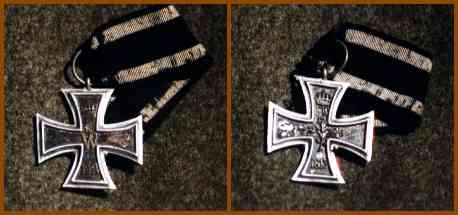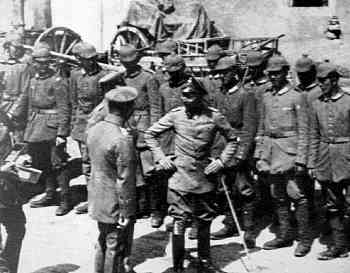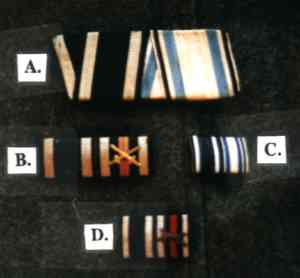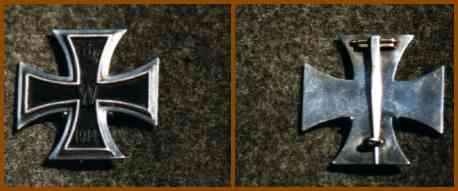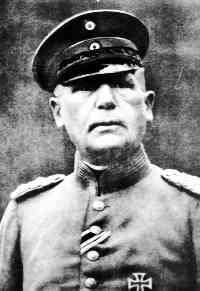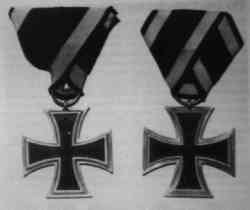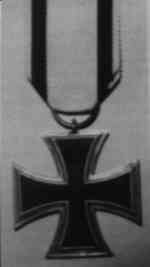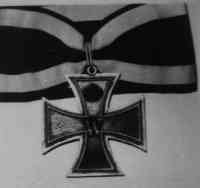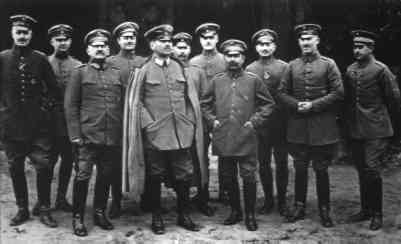
| Back | Special | Library | Search | Home | Help |
The 1914 German Iron Cross
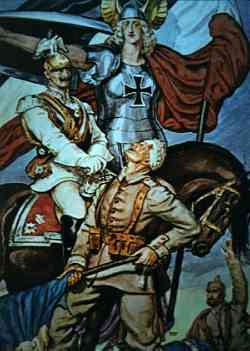 |
| A highly romanticized view of the Kaiser bestowing a battlefield award. |
Contributed by

Ralph Reiley (Reileys@worldnet.att.net)
The 1914 German Iron Cross
In the history of military decorations, few are as simple or striking
as the Prussian Eiserne Kreuz (Iron Cross). The award was
created in 1813, during the Napoleonic Wars. In 1807 Prussia was
defeated by Napoleon, and entered into unwilling subservience
to the French. Following Napoleon's retreat from Moscow in December
of 1812, the Prussian army, forcibly allied with the French, found
an opportunity to change sides, and allied themselves with Russia
against France. On March 20, 1813, a new medal was instituted
to commemorate the start of the war against Napoleon.
The new medal was designed by noted architect Karl Friedrich Schinkel.
It was a simple blackened iron cross, with continuous silver trim
around the edge. One face had a simple oak leaf sprig in the center,
with 1813 on the lower arm, and the Royal Cipher "FW"
and a crown in the upper arm, the other face was blank. Until
1838, the blank face was the official front side of the medal,
when the practice of wearing the medal with the face bearing the
oak leaves outward was approved.
Three grades of the medal were instituted, the Grosskreuz (Grand
Cross) for senior commanders; and the 1 Klasse (1st Class),
and 2 Klasse (2nd Class), for individual merit in combat.
The size of the 1st and 2nd class awards was about 42mm, and examples
range from 28-42mm. The 1st class medal had loops welded to the
rear side, so it could be sewn to the tunic. The 2nd class medal
was suspended by a ribbon ring attached to an eye welded to the
top of the medal. The ribbon was black with two white edge stripes,
the state colors of Prussia. A non-combatant version was also
issued, it's ribbon was white with two black edge strips. The
Grand Cross was a larger version of the award, about 62mm in size.
It was worn at the neck and suspended by a wider version of the
2nd class ribbon. Little change would be made to these medals
during the following 100 years.
The Iron Cross was intended to be awarded only in times of war.
During times of war it was intended to replace other traditional
awards as the Rote Adlerorden (Order of the Red Eagle)
or the Pour le Mèrite (known as the Blue Max during
W.W.1). In practice, all other medals were issued as well as the
Iron Cross. One Star to the Grand Cross was awarded to Generalfeldmarschall
Blücher, for his part in the victory at Waterloo. This medal,
also called the Blücherstern (Blücher Star),
was set in the center of a large silver starburst, and it was
worn on the chest, over the heart. The Prussians, as well as other
European states, had a long tradition of issuing awards in several
grades, or class, depending on the military rank and social standing
of the recipient.
After Waterloo, in 1815, the Iron Cross would not be awarded again
until 1871, just after the end of the Franco-Prussian War. On
July 19, 1870 the Iron Cross was instituted, but no medals were
issued until after the end of the war. The 1870 Iron Cross was
altered to commemorate the recent victory over France. The original
medal face, with the 1813 date was retained, but it became the
reverse side. The front of the 1870 medal had a crown in the upper
arm, the Royal Cipher "W" in the center, and 1870 in
the lower arm. The Grand Cross was awarded to nine individuals
in 1870, including one for Kaiser Wilhelm I. The Star to the Grand
Cross of 1870 was not issued.
In August of 1914, Germany was at war with France once again.
On August 5, 1914, the Iron Cross was instituted. It's design
was identical to the 1870 medal, with the date changed from 1870
to 1914. The Grand Cross of 1914 was awarded to Kaiser Wilhelm
II, Generalfeldmarshall von Hidenburg, General Ludendorf, Generalfeldmarshall
Prince Leopold of Bavaria, and Generalfeldmarshall von Mackensen.
During the Spring Offensive of 1918, the Kaiser awarded von Hindenburg
the only Star to the Grand Cross of 1914.
The construction of the medal is a blackened iron center, with silver trim around the edge, about 42mm (1 5/8") in size. Early war examples are usually marked with the '800' or '900' silver hallmark on the ribbon suspension ring. Ribbon widths vary from 25 to 30mm. As the war progressed, and silver and iron became more scarce, silver plated trim around an alloy center was used. Late in the war, solid brass, one piece medals were cast. A precise count of the number of medals awarded is impossible to verify today, as the Prussian Army records were destroyed in the bombing of W.W.II. The best estimate is somewhere between 1.5 and 5 million.
During the award ceremony, the ribbon, with medal attached, would
be placed through the 2nd button hole below the collar of the
tunic. The medal was usually sent home, and only the ribbon was
worn in the field. In 1915, the infantry tunic was simplified,
concealing the front buttons. The ribbon was sometimes sewn to
the tunic, on the button fly where the button hole would have
been. Later on a bar was made out of the ribbon, and worn on the
chest, over the heart along with various other wartime ribbon
bars.. Austrian recipients of the medal often folded the ribbon
into a triangular shape, to match the standard Austrian award
ribbon.
The construction of the medal is a blackened or lacquered iron
center set in a silver frame. The reverse side is plain silver,
with a silver pin on a vertical hinge. It is about 42mm (1 3/4")
in size. The medal is worn on the left side, about 2" above
the belt. From 1915 on, private purchase medals were produced,
some were flat like the issue medal, and others were slightly
vaulted, and had a screw post and washer/wing nut fastener on
them, or other type of elaborate fitting. Officers normally had
several uniforms, and if they could afford the expense, they would
purchase official jeweler's copies of all their medals and awards,
one set for each uniform they owned. The 2nd class medal was generally
shipped in a simple envelope, while the 1st class medal, and other
higher awards, came in a small case, often lined with silk or
velvet. Officers often kept their issue medals in these cases,
and only wore them on their dress uniforms or for special occasions,
wearing the jeweler's copies at other times.
As silver and iron became scarce, medals were produced with silver
plated trim and alloy centers. Some late war medals were produced
as one piece castings. As the war progressed, the quality of both
1st and 2nd class medals declined. Generally one had to have previously
been awarded the 2nd class medal, before the 1st class medal was
awarded. There were a few cases where the 1st class medal was
awarded first. The total number issued will never be known, estimates
vary from 80,000 to 250,000. This medal was mainly issued to officers,
although it was not uncommon for enlisted men to receive it.
The Iron Cross is a very popular item for collectors. This has
lead to the increase in the value of original medals, which has
lead to reproductions being made available in this country. This
is mainly a problem for the W.W.2 collector, where demand is high
and good quality reproductions are often sold as originals. W.W.1
medals are not in the same demand, so the sale of good quality
reproductions is not quite as profitable. In Germany high quality
reproductions of Imperial medals and ribbons are still being made.
They are sold as reproductions, and for far less than originals.
The German market for medals is mainly to replace a father's,
grandfather's, or other ancestors medals, since medals were very
popular mementos to 'liberate' by soldiers of victorious armies.
Iron is not used for the center of reproduction medals, so a simple
test with a magnet will determine the genuine article from the
dreck. This is not a absolute test, as late war medals also used
alloy centers. Novice collectors are reminded that knowledge is
power, and one should take the time to take a long hard look and
learn before parting with hard earned cash to an unscrupulous
dealer. For Further Reading
© 1997 Ralph Reiley - All rights reserved |


